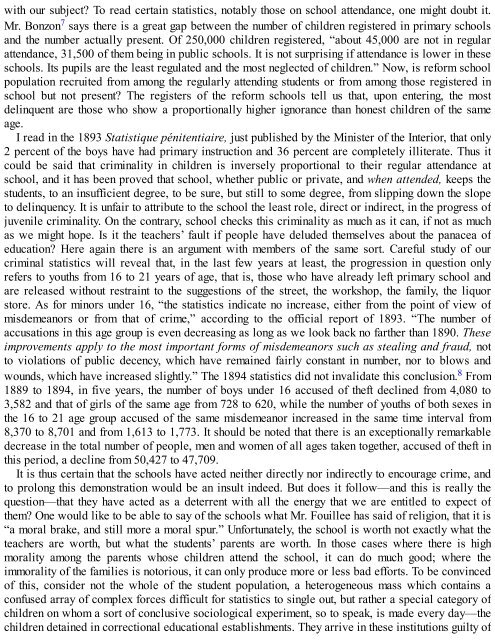3658925934
Create successful ePaper yourself
Turn your PDF publications into a flip-book with our unique Google optimized e-Paper software.
with our subject? To read certain statistics, notably those on school attendance, one might doubt it.<br />
Mr. Bonzon 7 says there is a great gap between the number of children registered in primary schools<br />
and the number actually present. Of 250,000 children registered, “about 45,000 are not in regular<br />
attendance, 31,500 of them being in public schools. It is not surprising if attendance is lower in these<br />
schools. Its pupils are the least regulated and the most neglected of children.” Now, is reform school<br />
population recruited from among the regularly attending students or from among those registered in<br />
school but not present? The registers of the reform schools tell us that, upon entering, the most<br />
delinquent are those who show a proportionally higher ignorance than honest children of the same<br />
age.<br />
I read in the 1893 Statistique pénitentiaire, just published by the Minister of the Interior, that only<br />
2 percent of the boys have had primary instruction and 36 percent are completely illiterate. Thus it<br />
could be said that criminality in children is inversely proportional to their regular attendance at<br />
school, and it has been proved that school, whether public or private, and when attended, keeps the<br />
students, to an insufficient degree, to be sure, but still to some degree, from slipping down the slope<br />
to delinquency. It is unfair to attribute to the school the least role, direct or indirect, in the progress of<br />
juvenile criminality. On the contrary, school checks this criminality as much as it can, if not as much<br />
as we might hope. Is it the teachers’ fault if people have deluded themselves about the panacea of<br />
education? Here again there is an argument with members of the same sort. Careful study of our<br />
criminal statistics will reveal that, in the last few years at least, the progression in question only<br />
refers to youths from 16 to 21 years of age, that is, those who have already left primary school and<br />
are released without restraint to the suggestions of the street, the workshop, the family, the liquor<br />
store. As for minors under 16, “the statistics indicate no increase, either from the point of view of<br />
misdemeanors or from that of crime,” according to the official report of 1893. “The number of<br />
accusations in this age group is even decreasing as long as we look back no farther than 1890. These<br />
improvements apply to the most important forms of misdemeanors such as stealing and fraud, not<br />
to violations of public decency, which have remained fairly constant in number, nor to blows and<br />
wounds, which have increased slightly.” The 1894 statistics did not invalidate this conclusion. 8 From<br />
1889 to 1894, in five years, the number of boys under 16 accused of theft declined from 4,080 to<br />
3,582 and that of girls of the same age from 728 to 620, while the number of youths of both sexes in<br />
the 16 to 21 age group accused of the same misdemeanor increased in the same time interval from<br />
8,370 to 8,701 and from 1,613 to 1,773. It should be noted that there is an exceptionally remarkable<br />
decrease in the total number of people, men and women of all ages taken together, accused of theft in<br />
this period, a decline from 50,427 to 47,709.<br />
It is thus certain that the schools have acted neither directly nor indirectly to encourage crime, and<br />
to prolong this demonstration would be an insult indeed. But does it follow—and this is really the<br />
question—that they have acted as a deterrent with all the energy that we are entitled to expect of<br />
them? One would like to be able to say of the schools what Mr. Fouillee has said of religion, that it is<br />
“a moral brake, and still more a moral spur.” Unfortunately, the school is worth not exactly what the<br />
teachers are worth, but what the students’ parents are worth. In those cases where there is high<br />
morality among the parents whose children attend the school, it can do much good; where the<br />
immorality of the families is notorious, it can only produce more or less bad efforts. To be convinced<br />
of this, consider not the whole of the student population, a heterogeneous mass which contains a<br />
confused array of complex forces difficult for statistics to single out, but rather a special category of<br />
children on whom a sort of conclusive sociological experiment, so to speak, is made every day—the<br />
children detained in correctional educational establishments. They arrive in these institutions guilty of









![Genki - An Integrated Course in Elementary Japanese II [Second Edition] (2011), WITH PDF BOOKMARKS!](https://img.yumpu.com/58322134/1/180x260/genki-an-integrated-course-in-elementary-japanese-ii-second-edition-2011-with-pdf-bookmarks.jpg?quality=85)
![Genki - An Integrated Course in Elementary Japanese I [Second Edition] (2011), WITH PDF BOOKMARKS!](https://img.yumpu.com/58322120/1/182x260/genki-an-integrated-course-in-elementary-japanese-i-second-edition-2011-with-pdf-bookmarks.jpg?quality=85)





